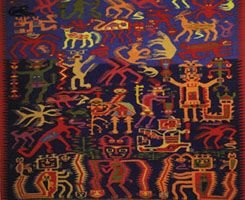 |
ASUR'S ANTHROPOLOGICAL AND CULTURAL EXTENSION ACTIVITIES
Casa Capellanica. Calle San Alberto No 413
Telefono (591) (64) 53841
Fax (591) (64) 62194
asur@mara.scr.entelnet.bo Casilla
662 - Sucre - Bolivia |

The Textile-Ethnographic Museum
Among ASUR's most important concerns is the Textile-Ethnographic Museum
it has established in the Casa Capellánica in Sucre. The museum contributes
to the project's goals by providing:
- a permanent display of the textiles produced by the ethnic groups that
make up the project.
- a place where the visitor can see and appreciate the textiles, while
at the same time learn about their significance within the cultural context
in which they were created.
- an interesting cultural and touristic attraction which hosts an average
of 600 persons per month.
- an ideal way to educate about and promote the textile project.
- a means of increasing the sale of textiles, through the textile shop
which is located in the same building as the Museum.
DESCRIPTION
The Museum consists of a reception room, 7 exhibition rooms, and a hall
where the weavers work in order to demonstrate the techniques used and designs
created.
MUSEUM SPACES
The Reception Room
Visitors are welcomed with a complimentary coffee service and a video system
featuring ethnographic videos, which tourists may request at will. In this
space specialized books (published by ASUR and other organizations) related
to anthropology, ethnohistory, and native cultures are sold. Postcards featuring
the textiles exhibited in the Museum, posters, and various brochures are
offered also.
As the intention is for the visitors to understand fully all of the information
presented, this information has been translated into English, French, and
German in the guide brochures which are available to the tourist during
his/her visit. In addition, the museum provides bilingual staff.
Room 1
This room provides information about the ethnic groups located around the
city of Sucre: among these are the Jalq'a and the Tarabuco, whose work forms
the basis of the Museum. The visitor is able to orient himself/herself using
a map which localizes the different communities. The room also presents
the "axsu", the principal piece to which the Museum is dedicated,
both in its present form and in the forms it has taken throughout its history.
Room 2
This is the room of the traditional costume: clothing of today and clothing
of the past. One display presents preColumbian pieces. Except for these
delicate pieces, the clothing is accessible to the spectator, who can touch
them and feel their texture.
Room 3
 |
This is the only room which displays the present-day textile work of male
weavers (all the other textiles are female creations). Just recently, men
have begun reviving techniques from the preColumbian past for the creation
of tapestries, of embroidery and of various types of more volumenous weavings
(technically called "anillodos"). This room exhibits their first
successes, which are extraordinary in that they do not arise out of an existing
millennial tradition, as do the techniques and designs of the women. |
Room 4
Mannequins, presented simply as silhouettes, display the regional costumes
used in traditional dances, especially the dances and rituals of Carnaval.
The base for the 'Carnaval' altar is a "pukara" -- a branch of
the 'molle' tree which must grow naturally divided into three parts; on
this altar are placed fertility offerings. This "pukara" constitutes
the ceremonial center of the room.
Room 5
This is the room for present-day Tarabuco textiles. Very finely-made,
very delicate, these textiles display designs ordered into bands; in these
bands are depicted - in miniature - the scenes and characters of community
life.
 |
This room contains a special light which seems to emanate from the gradations
in color typical of today's Tarabuco textiles: the greens, the wines, the
blues which cascade over the figures seem as if to highlight them with a
beam of light.
Click! in the textiles for
Zoom. |
 |
...More Rooms

[ASUR] [Geografic
Area] [Museum] [Textiles] |



